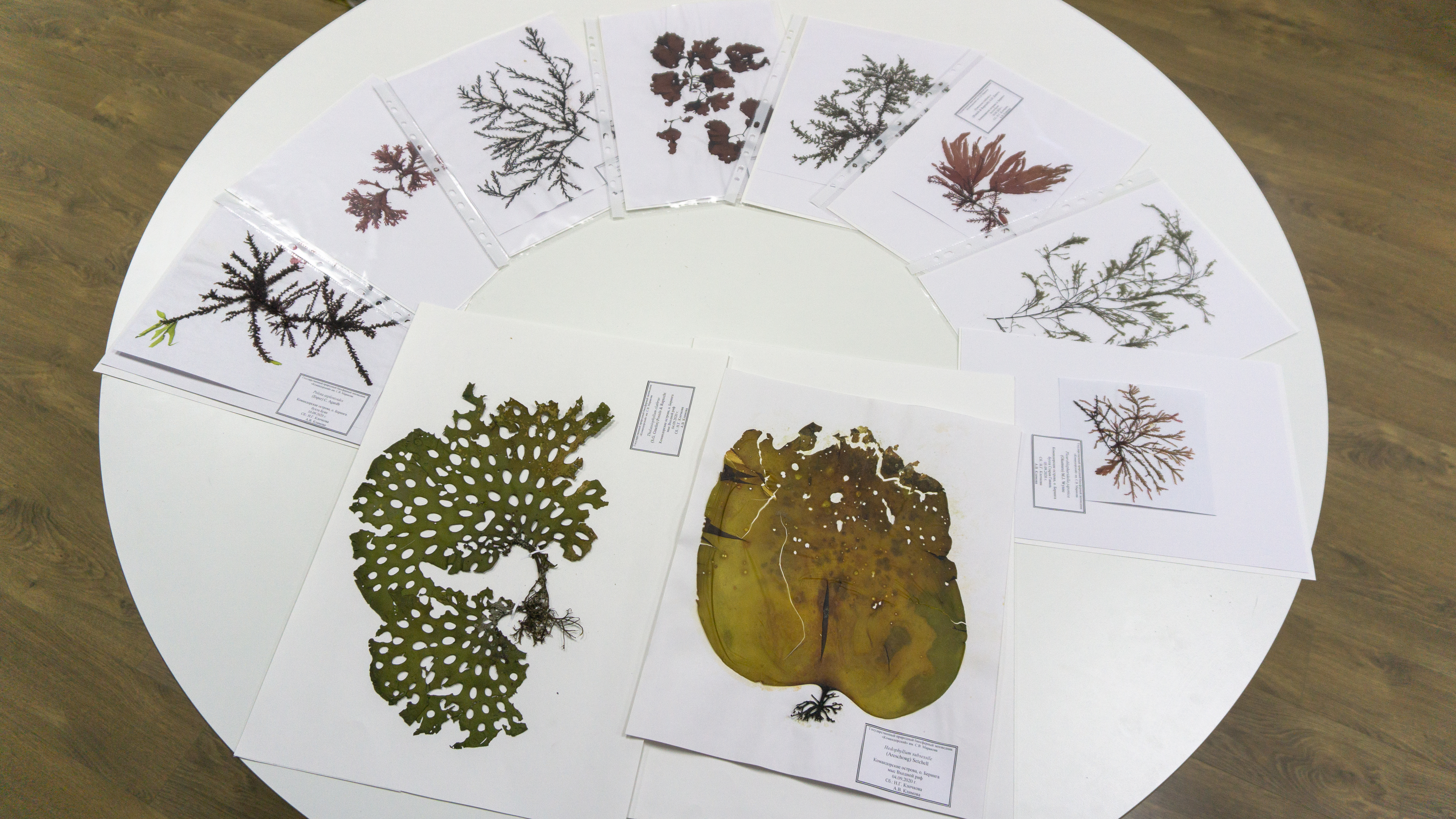New Algae for the CINBR Herbarium Its authors are employees of the Kamchatka State Technical University, Doctor of Biological Sciences Nina Grigorievna Klochkova and Ph.D. Anna Klimova. In September they conducted algofloristic studies on Bering Island.
Inventory of algal flora and compilation of algae herbarium. Photo by Press service of the reserve
“The herbarium contains mass species that we met in the fall on Bering Island,” said Anna Klimova. During the period of the field work, the researchers found 91 species of algae and prepared 441 herbarium leaves, including 10 leaves of representatives of green algae (Chlorophyta), 53 leaves of representatives of brown algae (Phaeophyceae) and 378 leaves of red algae (Rhodophyta).
Usually, samples of algae on the Commander Islands were collected in the summer, while their mass development is noted in autumn and spring, when cold-loving ephemerals appear in the flora along with perennial species. Therefore, it is not surprising that the list of macrophytes of the Commander Islands has been replenished with new algofloristic data. For a complete inventory of the algal flora of the Commander Islands and an understanding of algae development biology, their collection must be carried out all year round. This must also be done because earlier lists of the algoflora of this region indicate species, the finding of which near the Commander Islands requires confirmation or refutation. Under the conditions of the changing climate near the Commander Islands, alien species - invasives from neighboring coastal regions - can occasionally occur.
"Marine phytogeography can provide an answer to many questions of paleogeography and paleoclimate." Photo by Anna Klimova
Sublittoral studies near the Commander Islands were very limited and biometric analysis of some species of kelp was not previously carried out here. The guests of the reserve managed to carry out a lot of work in this direction, especially for representatives of the genus Hedophyllum and other species. During the study of littoral algae, an interesting phenomenon was discovered: we found a deep-sea seaweed algae Thalassiophyllum clathrus in a shallow littoral bath. “The same distribution of the species is noted in Alaska and the Aleutian Islands, and in Russian waters we record it for the first time on the Commanders. On Kamchatka and the Kuril Islands, this species is usually found in the sublittoral zone up to 20 meters deep, less often deeper,” Anna Klimova noted.
According to the results of the past field season, it became clear that the species that were previously considered rare for the Commander, known literally from single finds, are actually quite widespread, since in the fall after the end of the growing season "we often found them in coastal emissions." “For many years, since the establishment of the reserve, the scientific department has been working on replenishing the herbarium of higher vascular plants. Now, with the help of fellow algologists, work has begun on creating a herbarium of lower plants - algae. This is the first scientific algal herbarium in the history of the Reserve, which will serve for the systematization and inventory of algal flora on the Commander Islands,” said Evgeny Mamaev, Deputy Director for Science of the Commander Islands Nature and Biosphere Reserve. An updated list of marine vegetation will help to better understand the patterns of formation and functioning of the local ecosystem, as well as the role of algae in benthic communities.
"An updated list of marine vegetation will help to better understand the patterns of formation and functioning of the local ecosystem." Photo by Anna Klimova
Scientists of Kamchatka State Technical University have yet to clarify the herbarium list, since some algae cannot be identified visually, therefore it is necessary to study their internal structure under a microscope or even carry out genetic studies.The second stage of data processing will be to determine the content of heavy metals in algae.This information will be used to determine the background level for the Kamchatka waters, since the waters of specially protected natural areas are reference for monitoring work and work to determine the ecological state of coastal areas.
To this we add that the uniqueness of the underwater flora of algae-macrophytes of the Commander Islands is due to their geographical position. КThe Commanders are the last in the island arc connecting the North American continent with Eurasia. ЗHere the western border of the range passes for a number of species marching through the Aleutian Islands to Asia. Other American species are more "nimble" - they managed to reach southeastern Kamchatka and the Kuril Islands.
"To this we add that the uniqueness of the underwater flora of algae-macrophytes of the Commander Islands is due to their geographical position." Photo by Anna Klimova
Algae, unfortunately, are very rarely found in fossil remains, but marine phytogeography, nevertheless, can provide an answer to many questions of paleogeography and paleoclimate. The data of algofloristic studies in areas subject to long-term historical isolation are very important. This information is no less important for studying the consequences of global climate changes.










